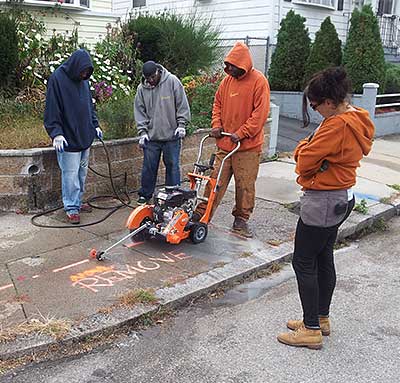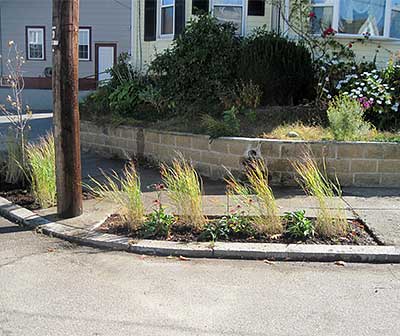Step by Step Green Infrastructure projects in Reservoir Triangle

Cutting away a section of the sidewalk.
Image Credit: Amelia Rose, Environmental Justice League of RI

The gardens that replaced the sidewalk.
Image Credit: Amelia Rose, Environmental Justice League of RI
- Asked residents in the neighborhood already involved in our project in various ways if they'd like to host a GI demonstration on their property. We also asked through other networks like parents of school kids we've worked with or who were involved in like-minded organization.
- Did a site/property assessment with Groundwork staff to determine best fit GI project at particular property. In the beginning we also talked with Bob McMahon at the Parks Dept for his ideas and guidance.
- Proposed the GI project to resident and modified it as needed. Made sure the resident was a homeowner, or had permission from the homeowner as well.
- For one property where we were did a public right of way, we could not ask the property owner's permission but we did talk to some of the residents and employees at the business where we were doing the work, to explain/promote the project.
- If we couldn't find a willing volunteer, we did some door-knocking just to ask if people were interested, sort of cold calling. That didn't work very well! But we did identify some public spaces that way where we could do some GI interventions.
- If the property was private, we just made a plan with the homeowner and Groundwork took care of getting the materials, the concrete cutters from Home Depot, the plants, the GeoBlock (textile), and we arranged for some of the projects to be done during their job training program.
- If the property was public land, we asked permission from Bill Bombard at the City Dept of Public Works. He always said yes. Since we were cutting up the sidewalks Groundwork had to prove they had insurance, and also purchase a $5,000 bond that our grant paid for. Bill waived another fee, a permit I believe, because we are a non-profit. The process for submitting the plans and design specifications to Bill, getting the bond, and getting the approval took about two weeks or so. Good to give more heads-up if possible.
- City Parks Director accompanied Groundwork staff to survey the site -- where to cut, how much room to leave for the sidewalk (3 ft I believe, to meet ADA regulations), and any other guidance. For one public right of way we left some concrete pavers in the planted bed for people to exit their cars, since a lot of people parked there on a daily basis.
- Groundwork staff called Dig Safe to have all utility lines marked -- called at least 2 weeks before the day the project started.
- We tried inviting members of the public, neighborhood, and area schools to see the projects in process -- Groundwork staff would explain what was being done and the process, how the GI would work.
- We placed educational signs at each of the demonstration sites.
- We have been going back to check in with the volunteer residents to see how things are going and to ask about maintenance, clear litter out of the way, check to make sure plants have taken and are growing, etc. We did leave an info sheet for residents about how to maintain their GI for some of them, but not at first -- and the in-person conversations always works better anyway. One resident’s rain barrel cap broke during the winter, for instance, because they didn't drain the barrel before it froze. So we went back and gave them another cap.
Amelia Rose - Co-Director - Environmental Justice League of Rhode Island
1192 Westminster Street - Providence - RI - 02909
(401) 383-7441 (office)
(401) 559-2204 (cell)
(401) 941-8156 (fax)